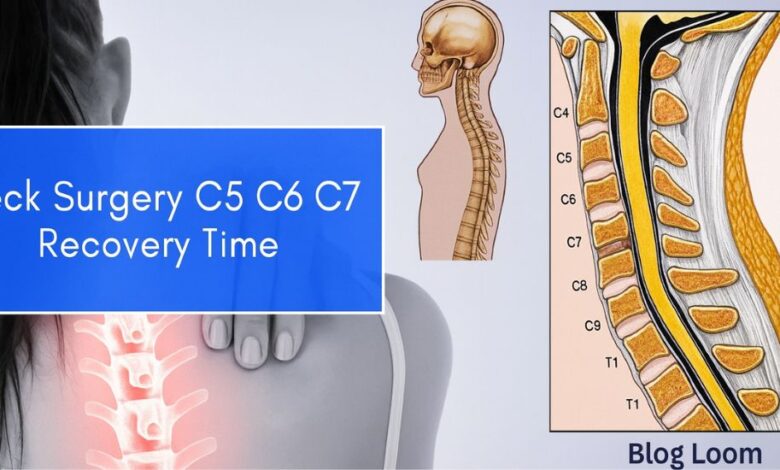Neck Surgery C5-C6-C7 Recovery Time: Pain, Sleep, and Long-Term Outlook

Neck surgery involving the C5, C6, and C7 vertebrae is one of the most common procedures for people suffering from severe cervical spine problems, such as herniated discs, spinal stenosis, or degenerative disc disease. The recovery journey can feel overwhelming, especially when you’re unsure what to expect in terms of pain, sleep, daily living, and long-term restrictions. This article provides an in-depth guide covering recovery time, pain expectations, hospital stay, self-care, and what nerves are affected by surgery at these levels.
Understanding C5-C6-C7 Surgery
The cervical spine consists of seven vertebrae labeled C1 through C7. The C5, C6, and C7 vertebrae form part of the lower cervical spine, an area commonly affected by disc degeneration, arthritis, and nerve compression. When conservative treatments fail, surgery may be recommended.
The most common surgeries at these levels include:
-
Anterior Cervical Discectomy and Fusion (ACDF): Removal of damaged discs followed by fusion of vertebrae using bone grafts and plates.
-
Cervical Disc Replacement: A motion-preserving alternative that replaces the damaged disc with an artificial implant.
-
Posterior Cervical Fusion or Laminectomy: Less common, but sometimes necessary for multi-level compression or severe spinal cord involvement.
Each surgical approach has slightly different recovery expectations, but most patients share similar timelines and concerns.
Neck Surgery C5-C6-C7 Recovery Time
Recovery after cervical spine surgery varies by individual, but general guidelines include:
-
Immediate Recovery (0–2 weeks)
-
Hospital stay usually lasts one night, sometimes two depending on the complexity.
-
Swelling, sore throat, and neck stiffness are common.
-
Activity is limited to short walks and basic self-care with assistance.
-
-
Early Healing (2–6 weeks)
-
Many patients can return to light desk work within 4–6 weeks if recovery is uncomplicated.
-
Physical therapy may begin to improve mobility and strength.
-
Driving is usually restricted until the patient is off narcotics and can move the neck safely.
-
-
Intermediate Recovery (6–12 weeks)
-
Fusion surgery patients continue healing as bone growth solidifies.
-
Most daily activities can be resumed gradually.
-
Physical therapy progresses toward strength and posture correction.
-
-
Long-Term Recovery (3–12 months)
-
Full bone fusion can take 6–12 months.
-
Patients may continue to experience mild stiffness, especially with multi-level fusions.
-
Final activity clearance—including exercise and sports—depends on surgeon approval.
-
In summary: Light activity is often possible by 6 weeks, but true recovery—including full fusion—takes up to a year.
What Is the Pain Like After C5-C6-C7 Surgery?
Pain levels vary, but patients typically experience:
-
Early Days (Hospital/Home):
Sore throat, neck stiffness, difficulty swallowing, and shoulder blade discomfort are common. This is often managed with prescribed pain medication and muscle relaxants. -
First 2 Weeks:
Pain gradually decreases but may fluctuate with activity. Shoulder and upper back aches are normal as muscles adjust. -
Nerve-Related Pain:
Some patients experience lingering numbness, tingling, or nerve “zingers” as compressed nerves begin to heal. This usually improves over time. -
Long-Term:
Most patients report significant pain relief compared to before surgery, especially regarding arm and nerve symptoms, though some stiffness is expected.
How Do You Sleep After Cervical Neck Surgery?
Good sleep is essential for recovery, but it can be challenging after neck surgery. Recommended practices include:
-
Best Position: Sleep on your back with your head elevated at about 30 degrees. A wedge pillow or reclining chair can help.
-
Pillows for Support: Use a pillow under your knees (if sleeping on your back) or between your knees (if side-sleeping). Avoid stomach sleeping as it strains the neck.
-
Collar Use: If prescribed, wear your cervical collar during sleep until cleared by your surgeon.
-
Real-Life Tip: Many patients find sleeping in a recliner for the first few weeks easier than lying flat.
How Painful Is Cervical Neck Surgery?
The surgery itself is performed under general anesthesia, so you won’t feel anything during the procedure. Postoperative pain is typically described as:
-
Moderate and manageable with prescribed painkillers.
-
More throat/neck soreness after anterior approaches (ACDF).
-
More muscle pain after posterior approaches, since muscles are dissected.
While uncomfortable at first, most patients find the pain tolerable and improving steadily each week. Compared to pre-surgical nerve pain, many feel immediate relief.
What Are Permanent Restrictions After Neck Fusion?
Permanent restrictions after neck fusion are less about daily living and more about protecting the surgical site long-term. Common permanent considerations include:
-
Loss of Motion: Expect 5–10% loss of neck mobility per fused level. For C5-C6-C7, that can mean noticeable but not debilitating stiffness.
-
Sports Restrictions: High-impact or contact sports (e.g., football, wrestling) are generally discouraged.
-
Heavy Lifting: Extreme heavy lifting that places strain on the neck, such as barbell squats with the bar pressing on the neck, may be avoided.
-
Normal Activities: Most everyday activities, including driving, desk work, light exercise, and travel, can resume once healing is complete.
What Nerves Are Affected by C5, C6, and C7?
Understanding nerve distribution helps patients make sense of their pre- and post-surgical symptoms:
-
C5 Nerve Root: Controls the deltoid and biceps, enabling shoulder abduction and elbow flexion. Provides sensation to the outer upper arm.
-
C6 Nerve Root: Controls wrist extension and assists biceps. Sensation spreads to the thumb and index finger.
-
C7 Nerve Root: Controls triceps and finger extension. Provides sensation to the middle finger.
Compression at these levels often causes arm pain, tingling, and weakness. Surgery typically relieves this pressure, allowing nerves to recover.
How Long Do You Stay in the Hospital After Neck Surgery?
Hospital stay depends on surgery complexity:
-
One-Level ACDF: Many patients are discharged the same day or after one night.
-
Two-Level or Multi-Level Fusion: Expect a 1–2 night stay for observation and pain control.
-
Posterior Fusion: Recovery is longer, often requiring 2–3 nights.
Patients are usually discharged once they can walk safely, eat and drink, and manage pain with oral medication.
Can I Take Care of Myself After Neck Surgery?
Immediately after surgery, you’ll likely need help with daily activities, including:
-
Dressing and bathing.
-
Preparing meals and doing errands.
-
Transportation, since driving is restricted until cleared.
Self-care timeline:
-
Light independence is possible within 1–2 weeks, especially for personal hygiene.
-
Lifting and strenuous chores remain restricted for at least 4–6 weeks.
-
Short, frequent walks are encouraged to promote healing and circulation.
Most patients can care for themselves gradually but benefit from family or caregiver support during the first two weeks.
Final Thoughts on Recovery
Recovery from C5-C6-C7 neck surgery requires patience and a clear understanding of the process. Pain, stiffness, and activity restrictions are part of the early weeks, but most patients report substantial improvement in nerve pain and overall quality of life as they heal. While permanent restrictions exist—especially regarding high-risk sports and some lifting—most people return to normal daily living and work within a few months.
If you are preparing for or recovering from cervical spine surgery, remember that every patient’s journey is unique. Follow your surgeon’s instructions, attend physical therapy, and give your body time to heal.
For more in-depth health guides and recovery tips, visit my blog Blog Loom, where we cover practical health insights and real recovery experiences.


